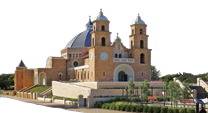Buzzword - Devotion to Mary
Before Vatican Council 11, with rare exception, devotion to Mary was largely observed by Catholic and Orthodox Christians. One of the fruits of the Reformation was to alienate many Christians from this devotion. However, since Vatican 11, many have noticed an apparent shift in Catholic and Protestant interest in the place of Marian devotion in Christian practice. All the major Christian churches are turning to a reading of the Scriptures and finding it impossible to deny the place of Mary within the belief and practice of the early Christian church.
Apoc 11:19;12:16,10: Christian tradition has seen fit to identify John's mysterious woman, suffering yet triumphant, with Mary.
1 Cor. 15: 20-26: This second reading from St. Paul emphasizes that death is the fate of everyone; but death does not have the final victory, unless we want it to! Christ's victory can be ours, as it was for Mary.
Luke 1: 39 - 56: The final reading from St. Luke's gospel shows Mary acknowledging her gratitude for the favors God has shown her.
Point 1: Pope Paul VI, in his encyclical - Marialis Cultus (Marian Devotion), encouraged Catholics to an increased use of the Bible; and Pope John Paul 11 in his letter "Mater Redemptoris (Mother of the Redeemer) and more recently with his introduction of the Mysteries of Light to be added to the recitation of the rosary, has drawn attention to "the special presence of the Mother of God in the mystery of Christ and His church."
From the Scriptures it is possible to trace a developing appreciation of Mary as mother and woman. But a purely biblical study only reveals a limited picture; it cannot tell the whole story, for the New Testament only concerns itself with the early beginnings of Christian reflection on the person of Mary. In the documents of the New Testament we have only the written record of faith and practice of the early Church. There was much more going on that did not get written, but which was passed on by word of mouth in those critical formative years. Eventually, these oral traditions were recorded by the early Greek, Syrian and Latin Fathers of the church. And it is here that we find the second great foundation stone of Christian teaching and practice - Tradition.
Point 2: Tradition is so important to the development of any culture - as the Fiddler in "Fiddler on the Roof" proclaimed "Tradition! Where would we be without our traditions"? It is on the grounds of constant tradition within Christianity that two important teachings concerning Mary have been proclaimed in comparatively recent years - the teaching on the Immaculate Conception by Pope Pius 1X in 1854, and the teaching on the Assumption of Our Lady given by Pope Pius X11 in 1950.
Conclusion: In this continuing study of Mary's place in Christian belief and practice, the Second Vatican Council has asked that we be careful to refrain from false and exaggerated devotion, but to remember that true devotion consists neither in sterile or shallow affection, nor in vain credulity, but needs to be based on verifiable faith.
Faith and Love caused Mary to respond positively to the invitation given to her to co-operate with God. We, too, have been invited to be one with Christ. The example of Mary's faith and love, hopefully, will encourage us to respond positively in order to share her triumph over death.
Scriptural reference: And Mary said, "My soul magnifies the Lord, and my spirit rejoices in God my Savior, [Luke 1:48] for he has looked with favor on the lowliness of his servant. Surely, from now on all generations will call me blessed;
